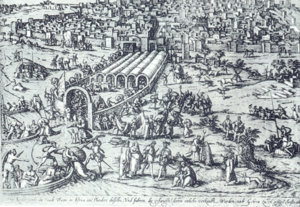Type a search term to find related articles by LIMS subject matter experts gathered from the most trusted and dynamic collaboration tools in the laboratory informatics industry.
| Conquest of Tunis | |||||||||
|---|---|---|---|---|---|---|---|---|---|
| Part of the Ottoman–Habsburg wars and the Ottoman–Portuguese conflicts | |||||||||
 Attack on La Goletta, with Tunis in the background  Entry of Charles V, Holy Roman Emperor, into Tunis in 1535 | |||||||||
| |||||||||
| Belligerents | |||||||||
|
|
| ||||||||
| Commanders and leaders | |||||||||
|
Charles V Andrea Doria Alfonso d'Avalos Álvaro de Bazán García de Toledo Duke of Alba Duke of Beja | Hayreddin Barbarossa | ||||||||
| Strength | |||||||||
|
Total men: 30,000–60,000
Total ships: 398 207 ships[4] 10 galleys 6 galleys 19 galleys Kingdom of Portugal 1 galleon, 2 carracks, 20 round caravels, 8 galleys 8 galleys 1 carrack, 4 galleys 60 hulks |
82 warships[5] 2 galleys[6] | ||||||||
| Casualties and losses | |||||||||
| Unknown: Many fell to dysentery[citation needed] |
30,000 Muslim civilians massacred[7] 9,000 Christians freed | ||||||||
The conquest of Tunis occurred in 1535 when the Habsburg Emperor Charles V and his allies wrestled the city away from the control of the Ottoman Empire.[8]
In 1533, Suleiman the Magnificent ordered Hayreddin Barbarossa, whom he had summoned from Algiers, to build a large war fleet for Constantinople.[9] Altogether 70 galleys were built in the winter of 1533–1534, manned by slave oarsmen, including 2,000 Jews.[10] With this fleet, Barbarossa conducted aggressive raids along the coast of Italy, then conquered Tunis on 16 August 1534, ousting the theretofore local ruler, Muley Hasan, who had been subservient to the Spanish[11][12] Barbarossa established a strong naval base in Tunis, which could be used for raids in the region, and on nearby Malta.[11]
Charles V assembled a large army of some 30,000 soldiers, 74 galleys rowed by chained Protestants[dubious – discuss] shipped in from Antwerp,[13] and 300 sailing ships, including the carrack Santa Anna and the Portuguese galleon São João Baptista (the most powerful ship in the world at the time) to drive the Ottomans from the region.[14] The expense involved for Charles V was considerable, and at 1,000,000 ducats on par with the cost of Charles' campaign against Suleiman on the Danube.[15] Unexpectedly, the funding of the conquest of Tunis came from the galleons sailing in from the New World, in the form of two million gold ducats extracted by Francisco Pizarro for releasing the Inca king Atahualpa, whom he nevertheless executed on 29 August 1533.[15]
Despite a request by Charles V, Francis I denied French support to the expedition, explaining that he was under a three-year truce with Barbarossa following the 1533 Ottoman embassy to France.[16] Francis I was also in negotiations with Suleiman the Magnificent for a combined attack on Charles V following the 1534 Ottoman embassy. Francis I only agreed to Pope Paul III's request that no fight between Christians occur during the time of the expedition.[16]
Having sailed from Sardinia at the head of a Catholic coalition protected by a Genoese fleet, Charles V destroyed Barbarossa's fleet on 1 June 1535 and after a costly yet successful siege at La Goletta, captured Tunis. In the action, the Portuguese galleon São João Baptista distinguished itself by breaking the chains protecting the harbour's entrance, thereafter opening fire on La Goletta. In the ruins, the Spanish found cannonballs with the French fleur-de-lis mark, evidence of the contacts stemming from the Franco-Ottoman alliance.[14]
The resulting massacre of the city left an estimated 30,000 dead.[17] Barbarossa managed to flee to Algiers with a troop of several thousand Ottomans.[5] Muley Hasan was restored to his throne.[5] The stench of the corpses was such that Charles V soon left Tunis and moved his camp to Radès.
The siege demonstrated the power of the Habsburg dynasties at the time; Charles V had under his control much of southern Italy, Sicily, Spain, the Americas, Austria, the Netherlands, and lands in Germany. Furthermore, he was Holy Roman Emperor and had de jure control over much of Germany as well.
Ottoman defeat in Tunis motivated them to enter into a formal alliance with France against the Habsburg Empire. Ambassador Jean de La Forêt was sent to Constantinople, and for the first time was able to become permanent ambassador at the Ottoman court and to negotiate treaties.[18]
Charles V celebrated a neo-classical triumph "over the infidel" first in Sicily and then at Rome on 5 April 1536 in commemoration of his victory at Tunis.[19][20][21] The Spanish governor of La Goulette, Luys Peres Varga, fortified the island of Chikly in the lake of Tunis to strengthen the city's defences between 1546 and 1550.
Barbarossa managed to escape to the harbour of Bône, where a fleet was waiting for him. From there, he sailed to accomplish the Sack of Mahón, where he took 600 slaves and brought them to Algiers.[22]
The Ottomans recaptured the city in 1569. Spain captured it again in 1573 under John of Austria, only to lose it again in 1574. Thereafter privateers from Tunis caused discord against Christian shipping. Raiding in the Mediterranean continued until the suppression of the Barbary pirates in the early 19th century.
A French invasion led to the establishment of French Algeria in 1830, consequently France would create a protectorate over Tunisia in 1881.